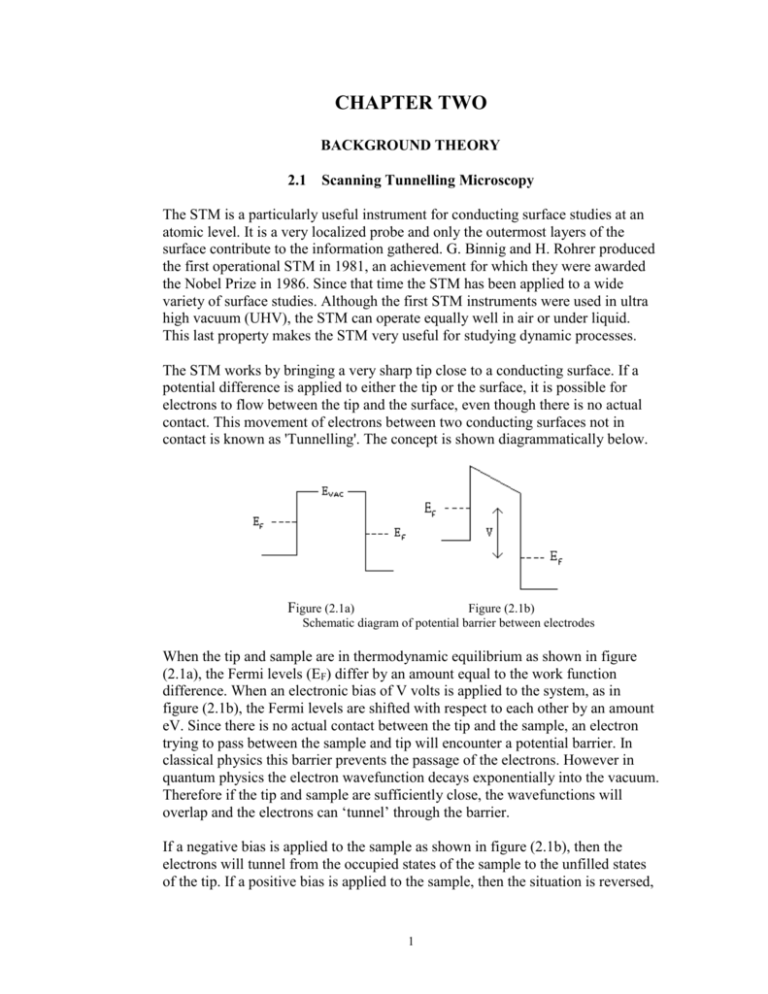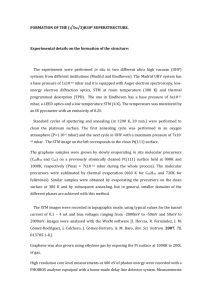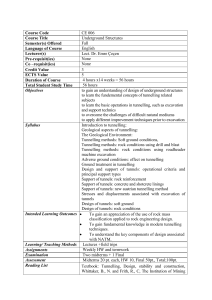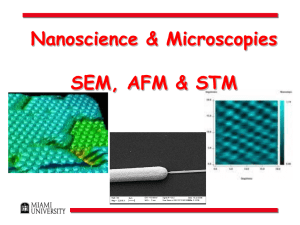Chapter 2 Theoretical Background
advertisement

CHAPTER TWO BACKGROUND THEORY 2.1 Scanning Tunnelling Microscopy The STM is a particularly useful instrument for conducting surface studies at an atomic level. It is a very localized probe and only the outermost layers of the surface contribute to the information gathered. G. Binnig and H. Rohrer produced the first operational STM in 1981, an achievement for which they were awarded the Nobel Prize in 1986. Since that time the STM has been applied to a wide variety of surface studies. Although the first STM instruments were used in ultra high vacuum (UHV), the STM can operate equally well in air or under liquid. This last property makes the STM very useful for studying dynamic processes. The STM works by bringing a very sharp tip close to a conducting surface. If a potential difference is applied to either the tip or the surface, it is possible for electrons to flow between the tip and the surface, even though there is no actual contact. This movement of electrons between two conducting surfaces not in contact is known as 'Tunnelling'. The concept is shown diagrammatically below. Figure (2.1a) Figure (2.1b) Schematic diagram of potential barrier between electrodes When the tip and sample are in thermodynamic equilibrium as shown in figure (2.1a), the Fermi levels (EF) differ by an amount equal to the work function difference. When an electronic bias of V volts is applied to the system, as in figure (2.1b), the Fermi levels are shifted with respect to each other by an amount eV. Since there is no actual contact between the tip and the sample, an electron trying to pass between the sample and tip will encounter a potential barrier. In classical physics this barrier prevents the passage of the electrons. However in quantum physics the electron wavefunction decays exponentially into the vacuum. Therefore if the tip and sample are sufficiently close, the wavefunctions will overlap and the electrons can ‘tunnel’ through the barrier. If a negative bias is applied to the sample as shown in figure (2.1b), then the electrons will tunnel from the occupied states of the sample to the unfilled states of the tip. If a positive bias is applied to the sample, then the situation is reversed, 1 and the electrons will tunnel from the occupied states of the tip to the unfilled states of the sample. In the diagram, the arrow indicates the range over which tunnelling can occur. Above this level there are no electrons to tunnel, while below this level there are no empty states into which electrons can tunnel. The solution to Schrödinger’s equation for an electron inside a one-dimensional rectangular barrier has the form = ekz 2.1 where the wave vector k is the important factor and has the form k2 = 2m(VB – E) 2.2 2 ћ E is the energy of the state and VB is the potential across the barrier. In the simplest case VB is the vacuum level. In this case VB – E is the work function. The probability of an electron Tunnelling through the barrier decays exponentially with barrier width d. I e-2kd i.e. 2.3 The work functions for metals are typically 4 – 6 eV. For a work function of 4 eV, the value for k is around 1Å-1. Using this value in equation 2.3, a change in current of 2% will mean a change in the gap distance of around 0.01Å. Or, to put it another way, the tunnelling current changes by an order of magnitude as the separation changes by 1 Å. This is the basic principle by which the STM detects changes in topography. Even very small changes in separation will show up as comparatively large changes in current. While the STM is working at the nanometre scale or larger, the interpretation of STM images as topography is fairly straightforward. However problems arise at the atomic scale. Binnig et al reported atomic resolution not long after the invention of the STM, but on the atomic scale, what is meant by topography? In order to properly interpret atomic scale STM images, a more precise understanding of how the STM imaging mechanism works is required. In 1957, Bardeen used first-order perturbation theory to develop a Hamiltonian approach to tunnelling. In this method the tunnelling current is; I 2e f E 1 f E f E 1 f E M , 2 E V E 2.4 where f(E) is the Fermi function, V is the applied voltage, M is the tunnelling matrix element between the states and of the tip and the sample, and E is the energy of the state . Bardeen also showed that under certain assumptions the tunnelling matrix could be approximated by; 2 M dS 2m 2.5 The integral is evaluated over any surface lying entirely within the vacuum space between the sample and tip. While these two equations are sufficient to calculate the matrix element and the tunnelling current, the tunnelling current, and hence the STM image, is actually a convolution of both the tip and the surface. In order to make accurate calculations the wave function of the tip, as well as the surface, must be explicitly known. Unfortunately the atomic structure of the tip is not generally known. Even if it were, accurate calculations would be difficult due to the low symmetry. On the practical side however, this appears not to be a major problem. As Tromp has pointed out, “on well prepared, clean and stable tips (such as W or PtIr), the tip wavefunctions are apparently sufficiently featureless so as to be undiscernible in the data.) Tersoff and Hamann showed that providing the matrix elements could be approximated by an s-wave function, it is possible to consider the tip as a point source of current regardless of its size. In this case the Tunnelling current for small voltages is; 2 I rt E E F r , EF 2.6 t This means the ideal STM would measure the local density of states (LDOS) at EF. In other words, the STM image is simply the contour of the charge density of states at the Fermi level, and is measuring a property of the bare surface without reference to the complex tip-surface region. The tip position rt, is interpreted as the centre of curvature of the tip wavefunction. Lang has verified that the image corresponds closely to a contour of constant (rdEF). This method has been tested on Au(110) and on Si(111) 7 x 7 with almost perfect agreement. Since the STM image is related to the LDOS of the sample, the image contains information not only on the topography of the sample, but also electronic information. This was shown very clearly by Stroscio et al in their study of GaAs (110). It had been predicted that there would be a charge transfer from the Ga atoms to the As atoms, resulting in the Ga dangling bonds being depleted and the As dangling bonds being more filled. This prediction was confirmed by experimentation when, at positive voltages, the Ga atoms were imaged, while at negative bias, the As atoms were imaged. This variation in the image with varying bias voltages as the result of variations in the energy window of states contributing to the tunnelling current, is the basis for a very important branch of STM studies, scanning tunnelling spectroscopy. (STS) For in situ STM experiments, the situation is not so clear. The tunnelling mechanism in liquid is unknown and the tunnelling barrier characteristics are 3 different from those in vacuum. For example, T. Pan et al studied barrier heights at various tip bias voltages in solution and found that an electron required more energy (0.5eV) to tunnel from the tip to the sample, than for the opposite. They attributed this to the alignment of water molecules in the tunnelling gap. They also observed a dip in barrier height around 0V bias, which they attributed to induced polarization of a cluster of molecules in the tunnelling gap. Nagatani et al studied barrier heights of Pt(III) and Au(III) in acidic solution and in UHV and found evidence for a lowering of barrier height in solution by about 1/3 compared to vacuum. They also found that even very small amounts of contaminants could have a substantial effect on barrier heights. However, despite these uncertainties, it is not difficult to obtain atomic resolution under liquid as the images below indicate. Figure (2.2) is an image of highly orientated pyrolytic graphite (HOPG) obtained in air. As will be explained in Chapter 3, only certain atoms in the HOPG are imaged by the STM. This results in a hexagonal pattern of atoms in the image. Figure 2.2 STM image of HOPG acquired in air. Bias voltage -0.05V Tunnelling current 5.14nA Size 40Å x 40Å As can be seen in the image, the “humps” representing the carbon atoms are easily visible, as is the hexagonal shape. Figure (2.3) also shows a small-scale image of HOPG, this time taken under liquid. (ultra-pure water) Again the carbon atoms are easily visible. 4 Figure 2.3 STM image of HOPG acquired under ultra-pure water Bias voltage -0.09V Tunnelling current 1.89nA Size 40Å x 40Å The third image, figure (2.4) is of a gold (110) crystal that was also imaged under ultra-pure water. Although the corrugations representing the gold atoms are many times smaller than those of carbon, which makes atomic resolution of gold much more difficult, the gold atoms can still be discerned. Figure 2.4 STM image of gold (110) acquired under ultra-pure water Bias voltage -0.003V Tunnelling current 3.73nA Size 60Å x 60Å 5 These two examples show that operating under liquid does not impair the imaging capabilities of the STM. This makes it a valuable tool for the study of dynamic processes and for in situ experimentation. 2.3 Scanning Tunnelling Spectroscopy Scanning tunnelling spectroscopy makes use of the electronic information inherent in an STM image to probe the eigenstates of the sample. By varying the bias voltage, different states become available for tunnelling, thus allowing spectroscopic investigation. Tunnelling spectroscopy is not a new technique, however the introduction of the STM has allowed spatially resolved spectroscopy to be undertaken. Also the spectral data can be obtained on an atom by atom basis due to the atomic resolution potential of the STM. This is a major advantage when compared to other surface spectroscopies. Nevertheless there are a number of difficulties in STS, not the least of which are the contributions by the tip, which are largely unknown and may lead to non-reproducibility in the data due to tip instabilities with voltage variation. There are a number of methods of obtaining spectroscopic information and the method used will largely depend on the type of information desired. This method has the disadvantage of requiring repeating scans for each voltage. 2.3.2 I/V spectroscopy One method of STS is Fixed Separation I-V Measurements. In this method an image is taken and then the tip is placed at various locations of interest. At each of these points the bias voltage is ramped between the negative and positive values of a preset bias voltage and a plot of Tunnelling current against applied voltage is obtained. While the plot is being obtained, the tip is held at a constant height above the surface. The resulting plot may be examined as a simple I/V graph. In this case, structure will appear as kinks in the graph, which are due to DOS features. An example of I/V spectra is shown below as figure (2.6), which shows I/V spectra on various regions of GaAs. The various band gaps are indicated and several kinks can be seen in some graphs indicating DOS features. 6 Figure (2.6) Current vs voltage measurements over various Cs structures on GaAs(110) Band structure indicated. These features can often be seen more clearly in a graph of the derivative of I-V. However the interpretation of these features is not totally straightforward as the derivative dI/dV does not have a simple relationship to the density of states (EF + V). Still a sharp feature in the density of states should produce a feature in the I/V spectrum or its derivative. These features can be seen in figure (2.7), which shows the normalized derivative spectrum of GaAs. Features that appeared as kinks in the I/V plot, appear as peaks in the derivative. Figure (2.7) Normalized derivative spectrum of GaAs(110) DOS features appear as peaks. 7 Another problem is that the barrier transmission coefficient is very strongly voltage dependent when the bias voltage is a sizable fraction of the work function. This can result in distortions to the spectrum features. Feenstra found a solution to this problem by normalizing dI/dV by dividing it by I/V, giving dlnI/dlnV which cancels out the exponential dependence of the barrier transmission coefficient on V. (Figure 2.7) This normalization is not required at small voltages as dI/dV is well behaved. 2.3.3 Current Imaging Tunnelling Spectroscopy Another method of conducting spectroscopy with an STM is Current Imaging Tunnelling Spectroscopy (CITS). Here an image is taken at a set voltage but at the same time an I/V spectrum is obtained for each point on the image. In this way current images may be constructed by displaying the measured current for any voltage. In addition, the I/V curves can be examined for any features. Hamers et al used CITS in analysing the Si(111) 7 x 7 surface. (See figure (2.8) below) It is important to note that current images obtained by CITS are in fact difference images. The measured current is the difference between the current at the bias voltage and at the sampling voltage. This can cause problems in interpreting the current images as they are very sensitive to variations in the “background" level of the current and may show spurious contrast. Figure (2.8) CITS images of occupied Si(III) - (7x7) surface states. (a) Adatom state at –0.35V, (b) dangling-bond state at –0.8V, (c) backbond state at –1.7V. 8 2.3.4 Conductance Spectroscopy A third method of gaining spectroscopic information was used in this project. In this method, the STM was set to obtain and display simultaneous topographic and spectroscopic images. The spectroscopic images were obtained by feeding a small modulation signal into either the Z-position signal or the bias voltage signal. A lock-in amplifier detects this modulation, and “locks in” on the modulation signal. In this way it is possible to not only produce a topographic image, but at each point to sample the current variation with bias voltage variation (local conductance) or with variation in distance. From this brief survey, it is clear that Scanning Tunnelling Spectroscopy in its various formats can provide very useful information. However the interpretation of the data must be made with caution. The situation becomes even murkier when tunnelling through liquid. As discussed earlier, very little is known about the tunnelling mechanism in liquid. Although the conducting of STM experiments in situ does not impair atomic resolution, very little theoretical investigation has been undertaken into in situ STS. Whether or not the reduction in barrier heights discussed earlier have any effect on tunnelling spectroscopy is unclear and this is an area where there is considerable scope for theoretical work to be undertaken. As Tromp has pointed out, there is no sure and simple way to understand what the researcher has from their STS. 2.4 Density of States Since an STM image is related to the LDOS and DOS features can cause features in STS, an investigation was conducted into what differences might be expected in the spectrum of different materials. The investigation was of the form of a convolution of the DOS of several materials with the DOS of platinum near the Fermi level, which approximates a delta function. The platinum DOS was used as all of the spectra were obtained using platinum tips. The DOS data was taken from Papaconstantinopoulos, who derived the data from; “the results of first principles band structure calculations, using elaborate augmented plane wave (A&W), Green’s function (KKR), linear combinations of Gaussian orbitals, approaches (which) can be recast on a linear combination of orbitals basis using the Slater-Koster method as an interpolation scheme.” The convolution was performed using the convolution function in the “LabView” software package. The materials used were silicon, carbon, gold, silver, platinum, and copper. Figures (2.9 – 2.15) below, show the results of the convolution. The graphs on the left show the convolution over the entire range of DOS while those on the right show the convolution close to the Fermi level of each element. The reason for these more detailed graphs is that the STS were conducted over a narrow voltage 9 range around the Fermi level to avoid any electrochemical reactions between the tip and the solution. As can be seen from the graphs, there are differences between the elements, however the most substantial differences are between the non-metals and the metals. In both silicon and carbon, a band gap is noticeable near the Fermi level where the DOS is zero, however with the metals the DOS is never zero. This is an indication that differences should be observable in the spectrum of silicon and carbon, and the metals. These differences are more clearly visible in the righthand graphs. Figure (2.9a) Convolution of the DOS of Platinum near the Fermi level and the DOS of silicon. Figure (2.9b) View of the convolution near the Fermi level for silicon. Figure (2.10a) Convolution of the DOS of platinum near the Fermi level and the DOS of carbon. Figure (2.10b) View of the convolution near the Fermi level for carbon 10 Figure (2.11a) Convolution of the DOS of platinum near the Fermi level and the DOS of copper. Figure (2.11b) View of the convolution near the Fermi level for copper Figure (2.12a) Convolution of the DOS of platinum near the Fermi level and the DOS of gold. Figure (2.12b) View of the convolution near the Fermi level for gold. 11 Figure (2.13a) Convolution of the DOS of platinum near the Fermi level and the DOS of Silver. Figure (2.13b) View of the convolution near the Fermi level for Silver. Figure (2.14a) Convolution of the DOS of platinum near the Fermi level and the DOS of platinum. Figure (2.14b) View of the convolution near the Fermi level for platinum. Regarding the metals, very little difference is observable in the right-hand graphs with the exception of platinum. Whereas the other three metals examined show a relatively flat and featureless DOS around the Fermi level, platinum shows a distinct peak just below the Fermi level. (Figure 2.13b) This would indicate that a feature should be expected in the spectrum. However, this increase in DOS arises from states in the “d” shell levels to which, as mentioned earlier, STS is not 12 sensitive. With the “d” shell DOS removed, the DOS around the Fermi level is very similar to that of the other metals, as shown in (Figure 2.15). Figure (2.15) View near the Fermi level of platinum of the convolution of the DOS of platinum near the Fermi level with the DOS of platinum less the DOS of the “D” level. This similarity means that theoretically it would very difficult to distinguish between these four metals using STS, given the very narrow voltage range used for in situ STS. However with the large differences between silicon and carbon, and the metals, it was expected that in situ STS would be able to differentiate these. An attempt was made to model the DOS of AuCN and Au(CN)2-, however the results were inconclusive. This left open the question of whether or not it was possible to differentiate between elemental gold and gold compounds using in situ STS. This was considered an important goal in order to assist in the understanding of the form in which gold is adsorbed onto carbon in the CIP process. 13








